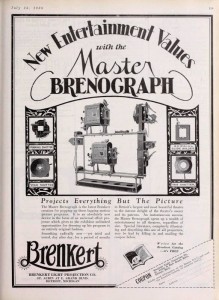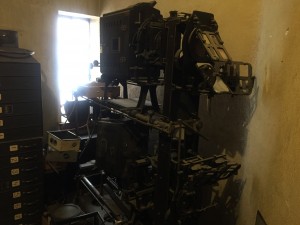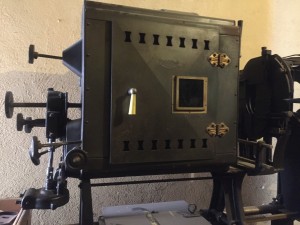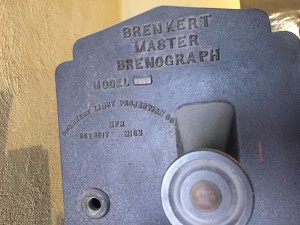SMITH HISTORY BLOG: A Canopy of Clouds
by Chris Woodworth
“A canopy of clouds moving across a field of twinkling stars is used in the atmospheric theatre to complete the illusion that pictures are being viewed beneath nocturnal skies.” Thus begins the text of an ad for one of the Brenkert projectors, the signature brand of equipment for movie palaces that were designed to bring the outdoors in (qtd. in Hall 94). When the Smith Opera House re-opened as the movie palace, Schine’s Geneva Theatre in March 1931, it boasted a Master Brenograph F7 projector, designed and built by the Brenkert Light Projection Company in Detroit, Michigan. In his book The Best Remaining Seats: The Golden Age of the Movie Palace, Ben M. Hall describes the Master Brenograph as a “super magic lantern” capable of projecting “song slides for the organ interludes […] an endless variety of scenic effects by means of multiple lenses and moving slides and intricate fades and dissolves” (197-198). Hall notes that in the 1928 catalogue for the Master Brenograph, the featured effects included “Aurora Borealis, Babbling Brook, Blizzard, Descending Clouds (for imaginary ascension trip), Flying Angels, Flying Birds, Flying Butterflies, Fire and Smoke, Flames, Lightning, Fast-moving Dark Storm-Clouds, Slow-moving Fleecy Clouds, Moving River, Ocean Waves, Rain, Sand Storm, Snow, Volcano in Eruption (with flowing lava and rain of fire and ashes), Waterfall, Waving American Flag, Flying Fairies, Flying Aeroplanes, Falling Roses, Twinkling Stars, Rainbow, and Rising Bubbles” (198). The Master Brenograph was a versatile machine and yet, as a 1928 advertisement declares, “Projects Everything but the Motion Picture.”
Operating the Master Brenograph took specialized skill and timing. In a 2009 issue of The Magic Lantern, Mark Butterworth details the technical elements of the Brenograph and how it would have been run by a talented projectionist. The lamphouses of the Brenograph contain “75 ampere vertical feed carbon arc burners.”
The Brenograph contains an upper and a lower lantern, which are run separately, each needing constant attention. Butterworth notes that “the only direct linkage” is a “fader on the front.” He goes on to assert that the “arc feed needed adjustment every 30 to 45 seconds” (3-4). We can only imagine how warm it must have been standing so close to this machine, constantly making small adjustments to keep it running! In addition to adjusting the burners, the projectionist would move the lanterns forwards and backwards along rails, in order to focus the images on different surfaces within the theatre or on the stage. Brenographs could project still slides (used primarily for ads) or panoramas. Some were outfitted with an “aluminum canister (similar to a movie reel container) with a clockwork drive mechanism.” This canister rotated, facilitating the appearance of an image moving across the space (Butterworth 7). For The Smith, the Brenograph was presumably used to project clouds moving across the interior sky. This special effect accounts for the nickname often given to projectors such as these: cloud machines.
In a booklet that was published on the history of the Master Brenograph, Thomas J. Mathiesen recounts how ubiquitous the projectors were, asserting, “In the late 1920s, every deluxe movie palace had as part of its requisite equipment at least one ‘Master Brenograph F7’” (1). And yet, as he goes on to explain, “With the coming of sound films, the depression, and major changes in theatrical exposition after 1930, most of the Breno- graphs were pushed aside, forgotten, and eventually sold for scrap. Today, only a few Brenographs survive at all, with a mere handful of them still operable and in their original locations” (1). It is therefore all the more astounding that The Smith Opera House is still in possession of its Master Brenograph.
Long since inoperable, the projector is stored adjacent to the projection booth. If you’d like to take a look yourself, join us on one of our Opera House History Tours!
Works Cited
Butterfield, Mark. “The Brenkert F7 Master Brenograph Lantern.” The Magic Lantern Gazette, vol. 21, no. 2, 2009, pp. 3-10. https://library.sdsu.edu/pdf/scua/ML_Gazette/MLGvol21no02.pdf
Hall, Ben M. The Best Remaining Seats: The Golden Age of the Movie Palace. Da Capo Press, 1988.
Mathiesen, Thomas J. “’Projects Everything But the Pictures’: The Brenograph and the Brenkert Light Projection Company,” 2017. http://fwembassytheatre.org/wp-content/uploads/2016/11/Complete_booklet_web.pdf



